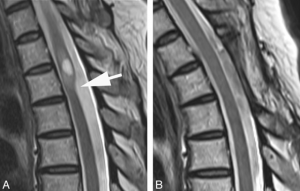Thoracic arachnoid web myelopathy
I met a patient recently who had an interesting condition I’d not come across before. First, a bit about his history:
 He was a gentleman around 60 years old who had deteriorating lower limb symptoms for the last 10 years. These included weakness, sensory changes and spasticity. He’d been to several doctors and claimed he usually felt “fobbed off”. They did scan his lumbar spine which didn’t show any abnormalities. He was fit and healthy prior to his symptoms and regularly played tennis. As it progressed he got to the point he was struggling to walk. As his symptoms continued to worsen he met a different doctor who really listened to him. He ordered a full spine MRI which showed he had a thoracic web myelopathy.
He was a gentleman around 60 years old who had deteriorating lower limb symptoms for the last 10 years. These included weakness, sensory changes and spasticity. He’d been to several doctors and claimed he usually felt “fobbed off”. They did scan his lumbar spine which didn’t show any abnormalities. He was fit and healthy prior to his symptoms and regularly played tennis. As it progressed he got to the point he was struggling to walk. As his symptoms continued to worsen he met a different doctor who really listened to him. He ordered a full spine MRI which showed he had a thoracic web myelopathy.
What is a thoracic arachnoid web myelopathy?
We all have a layer of translucent tissue around our spinal cord called the arachnoid membrane. It’s fibrous appearance is thought to look like a spiders web, hence the name arachnoid web. In very rare cases you can get a thickening of the arachnoid layer which can compress the spinal cord. This can affect how electrical signals are transmitted down to your lower limbs. This can cause symptoms such as altered reflexes, weakness, sensory changes, spasticity, altered gait and neuropathic pain. The symptoms you get depend on the level and severity of the spinal cord compression. All functions of the spinal cord above the level of compression remain unimpaired.
Diagnosis
Arachnoid web deformities are most common in the thoracic spine and are diagnosed via a Sagittal MRI. They look for something called the scalpel sign where the distortion in the cord appears anteriorly displaced and resembles the profile of a surgical scalpel.
Surgery
The surgical process aims to relieve spinal cord compression and resume normal cerebrospinal fluid flow dynamics. In most instances patients first have a laminectomy (removal of part of the vertebrae called the laminate) to expose the spinal cord. Microsurgery is then conducted to dissect the arachnoid layer away from the spinal cord and relieve the pressure. The outer layer of the membrane is then closed to prevent the leakage of cerebrospinal fluid and the surgery is complete
Outcome
Unfortunately, due to having some level of compression for 10 years, the surgeon explained he did not feel the patient will make much improvement. The primary objective of the surgery was to prevent further deterioration. The patient is currently on my caseload where we are looking to improve his strength, provide techniques to manage his spasticity and work on his gait cycle. I’m optimistic we will make some meaningful improvement but myself and the patient have a strong understanding that he will not return to his pre-compression ability. This is important as managing expectations can often be challenging.

